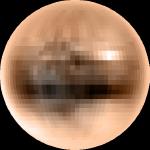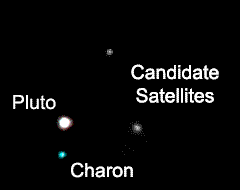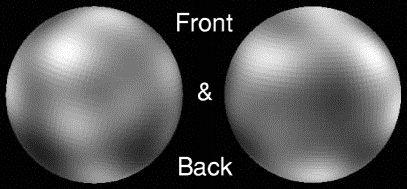
 |
Pluto - the furthest out! |
|
| |
Photo Credit: Eliot Young [SwRI] et al., NASA
Vital StatsPluto is usually the furthest planet from the Sun, but due to its highly elliptical orbit, it is sometimes closer than the planet Neptune. It is easily the smallest planet, only half the size of Mercury. It is also a rocky planet, unlike its nearest neighbours. Due to its extreme distance from the Sun, the surface temperature is only -230°C. Three Moons!In May 2005, the Hubble Space Telescope revealed two more tiny, and therefore extremely faint, moons! Provisionally called S/2005 P1 and S/2005 P2, the new moons have estimated diameters between 40 and 125 miles (64 and 200 km). Its main moon, Charon, is about 730 miles (1170 km) wide, about half the diameter Pluto.  Fig. 1: Pluto and its moons [Image credit: NASA, ESA et al.] The two moons orbit approximately 27,000 miles (44,000 km) away from Pluto, 2-3 times as far as Charon. However, they are thousands of times fainter which is why they were so hard to spot. Faint Glimpse...Pluto's surface remained invisible to observors on Earth until mid-1994 when the Hubble Space Telescope (HST) showed highly-contrasting surface features, including a northern polar cap (fig. 1). These features undoubtedly alter with time as frosts migrate across its surface.  Fig. 2: Pluto, as seen by Hubble Pluto's main satellite, Charon, orbits Pluto at exactly the same speed as Pluto rotates. This tidal coupling means that it 'hangs' stationary in the sky, seemingly motionless. |
Surprise Discovery!For many years astronomers had observed slight problems with the orbits of Uranus and Neptune. They assumed that there was a more distant planet that was pulling them off course. The hunt began with predictions of where the body could be. In 1930 Pluto was discovered - but it was far too small to exert enough force to alter the other planets' orbits by the amount seen. More surprising still is that Pluto was named by an 11 year old girl, Venetia Burney, who celebrated her 87th birthday in 2005. Venetia is a retired teacher from Epsom, Surrey. Planned Visit!Little else is known about Pluto, as it currently remains the only planet in the solar system not visited by spacecraft from Earth. This is all set to change, however, as NASA have approved a probe for launch in 2006.
Planet XEver since 1930, astronomers have continued to hunt for a tenth planet that must be causing the perturbations in the outer planets' orbits. They have yet to find the real culprit, but have found other planet-sized objects.Read more on planet X. Mythical Icons | Map of Pluto |
|
Sun | Mercury | Venus | Earth | Moon | Mars | Asteroids | Jupiter | Saturn | Uranus | Neptune | Pluto | Kuiper | |